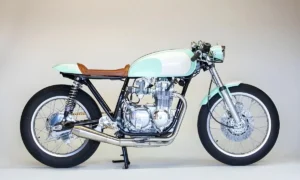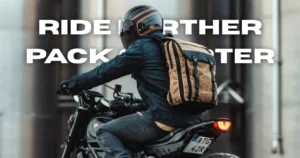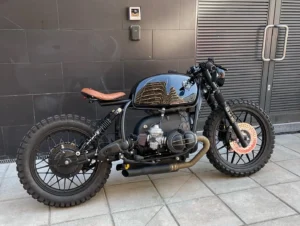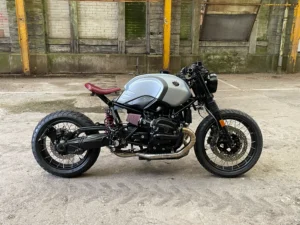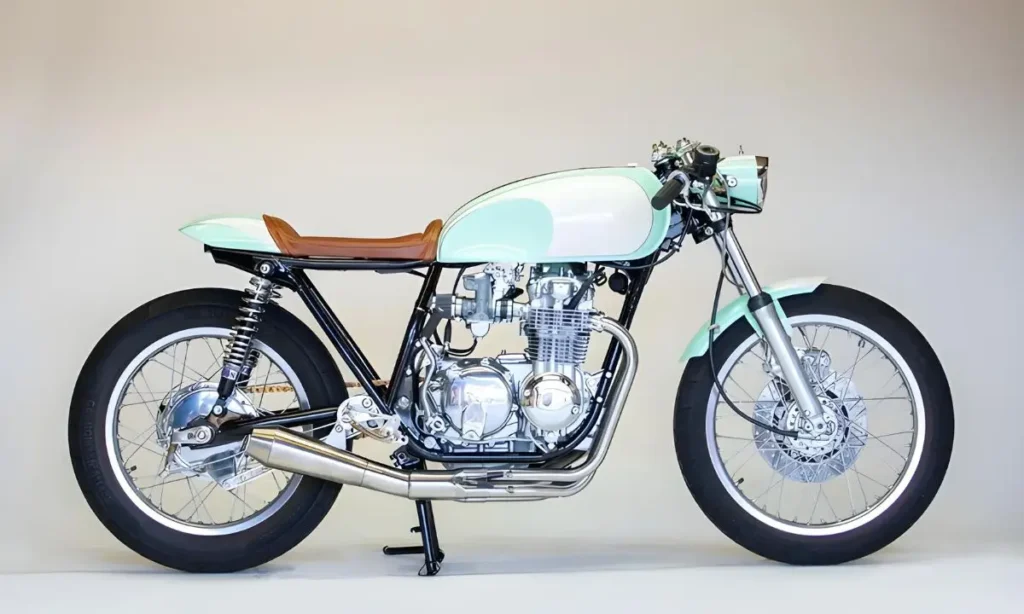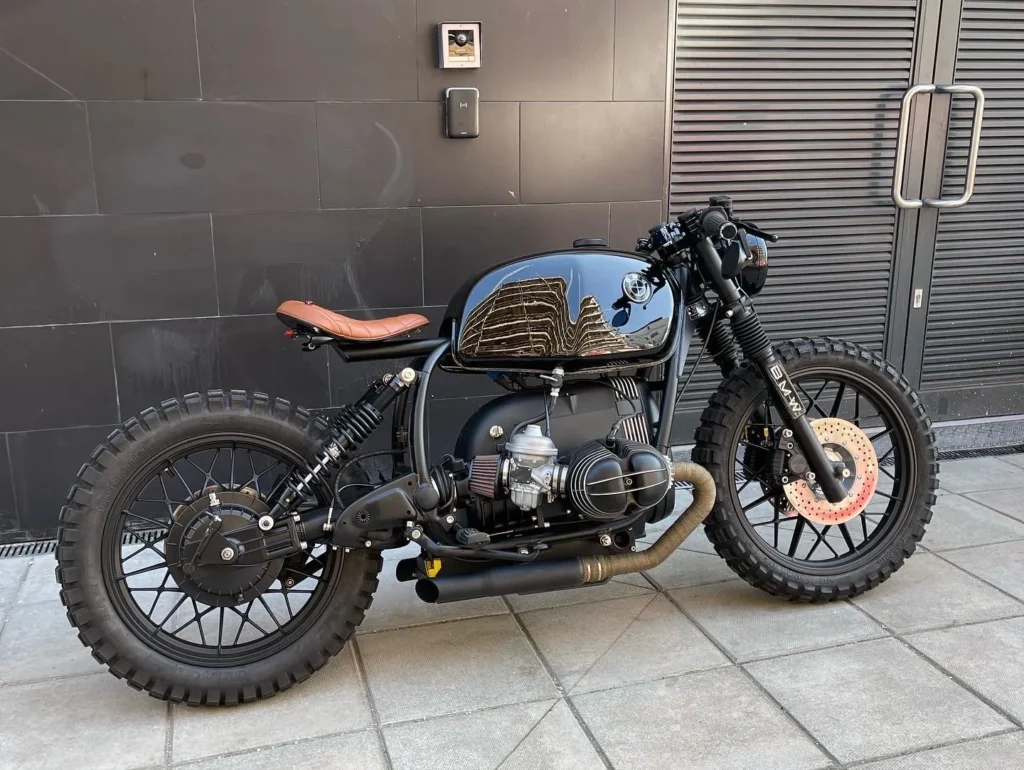Table of Contents
ToggleSo, you have a BMW K1100 and want to turn it into a café racer. First, welcome! The BMW K1100 is a great bike, and making it into a café racer is fun and will give you a cool ride.
When building a café racer, suspension is important. It’s not just about the look, though the lowered style is one reason we love café racers. It’s also about how the bike performs. The right suspension makes your bike easier to control, more comfortable, and safer.
In this guide, I’ll help you choose the right suspension for your BMW K1100 café racer. Whether you are new to bike building or have done it before, I’m here to help. By the end, you’ll know what upgrades to get and how to make your bike ride and look great.
Understanding Suspension Components and Terms
Let’s start with the basics. The technical terms can seem hard, but we’ll make them simple. Here are the main parts you’ll deal with when upgrading the suspension on your BMW K1100 café racer.
Forks
The front suspension, or forks, is what you see on the front wheel. On the BMW K1100, these are usually telescopic forks. But, you may want to upgrade them if you want a sportier feel.
Inverted forks are a common upgrade for café racers. They are stronger and give better handling because of how the weight is spread. You will notice the difference when you lean into a corner.
Rear Shock
The rear shock keeps the back wheel on the ground and softens bumps. The K1100 has a monoshock, which is one shock absorber connecting the back wheel to the frame. It works well, but if you want a better ride, there are aftermarket options that give you more comfort and control.
Key Terms to Know
Here’s a quick guide to some terms you’ll see when upgrading your suspension:
- Spring Rate: This shows how hard or soft the spring is. A higher rate means a stiffer ride, which helps with performance but might feel less comfy.
- Damping: This controls how the suspension moves. It helps absorb bumps and keeps your ride smooth.
- Preload: Preload is the tension on the spring before you sit on the bike. Adjusting it helps set the ride height and handling.
- Rebound Damping: This controls how fast the suspension returns to its normal position after being compressed.
Get these basics right, and you’ll be ahead when choosing the perfect suspension for your BMW K1100 café racer.
Stock vs. Aftermarket Suspension Options
Now comes the fun part (but don’t worry, it’s easy). Should you keep your stock suspension or upgrade it? Here’s the deal: if you care about how your car performs or looks, go with the upgrade.
Stock BMW K1100 Suspension
The stock suspension on a BMW K1100 is okay. It’s built for comfort because it’s made for touring. But it’s not great for sporty riding or looks. The front forks and rear shock work fine, but they aren’t made for fast riding or a café racer style.
One big problem with the stock suspension is that you can’t change it much. You have to use what BMW gave you unless you want to make big changes.
Aftermarket Suspension Options
Now is the time to make your ride your own. Let’s look at some popular suspension upgrades for the BMW K1100.
- Öhlins: If you want the best, choose Öhlins. They make high-quality shocks that you can adjust. They are expensive, but you’ll feel a big difference in how your bike handles.
- Ikon Suspension: If you don’t want to spend too much, Ikon has great options. They are not as adjustable as Öhlins, but they still improve your bike. Plus, they give it a cool retro look.
- TFX Suspension: TFX makes great suspension kits, especially if you want to change your front forks. Their shocks are fully adjustable, which is perfect for café racer fans.
You should also consider progressive springs. These help give you a smoother ride by adjusting to the bumps in the road. They can handle both small bumps and big hits.
How to Choose the Right Suspension Based on Riding Style?
Now that you know the parts and your suspension options, the next step is to choose the best one for your riding style. This is very important because it can change your whole experience on the bike. I’ve seen it happen a lot—someone picks a suspension that looks great but doesn’t match how they ride. This can lead to a rough ride or even safety problems.
Here’s the thing: suspension isn’t the same for everyone, especially if you’re turning your BMW K1100 into a café racer. Whether you want performance, comfort, or just a good look, your suspension needs to fit your goals.
Performance-Oriented Riders
If you like to push your bike hard, going fast and turning tight corners, you need a strong suspension. A stiff setup helps. A higher spring rate stops the bike from dipping too much when braking or lowering too much when speeding up.
For riders focused on performance, here are some key tips:
- Stiffer Springs: Choose springs with a higher rate. This improves control and keeps the suspension steady during tough rides.
- Adjustable Damping: This is very important. Adjustable damping lets you fine-tune how the bike reacts to the road and your riding style. Brands like Öhlins or TFX offer this feature.
- Fork Upgrades: You may want to upgrade your front forks too. For example, riders building BMW K1100 café racers often replace stock forks with sportbike-style ones, like those from the BMW S1000RR. These forks give better control for high-speed rides.
In short, if you care about performance, invest in top parts like Öhlins or adjustable shocks. It might cost more, but it’s worth it when you feel the difference on the road.
Comfort-Focused Riders
Not everyone likes to race or take sharp corners. Some people enjoy a calm ride, focusing on comfort and not feeling every bump in the road. If that sounds like you, your needs are different.
For riders who want more comfort, here’s what to look for:
- Softer Springs: A lower spring rate makes your suspension softer. This helps your bike absorb bumps better, giving you a smoother and more comfortable ride.
- More Suspension Travel: You’ll want a suspension with more travel, which helps take on bumps easily. The downside is that it may slow down handling, but it’s worth it for comfort.
- Progressive Springs: These springs start soft and get firmer as they compress. They give a smooth ride over small bumps and still handle big bumps well. These are great if you’re cruising around town or taking long rides.
Aesthetic Considerations
Let’s be honest. One reason we build café racers is that they look cool. The low, sleek style gives them a classic look. But lowering your suspension can affect how your bike rides.
If you want to lower your BMW K1100 for that café racer look, here are a few things to think about:
- Lowering Kits: You can buy kits that lower your bike. This gives you the look you want, but it also reduces suspension travel. This might make the ride rougher and hurt handling, especially at high speeds.
- Steering Geometry: Lowering the front or rear of your bike changes how it steers. Lowering the front helps the bike turn faster, but too much can make it unstable. Lowering the rear makes the bike more stable, but it might feel slow when turning. It’s all about balance.
Here’s a tip: Don’t lower the bike too much unless you’re sure. A small drop can improve the look without hurting performance.
Summary
The right suspension for your BMW K1100 café racer depends on how you ride. If you like performance, go for stiffer springs and adjustable damping. You could even swap the fork for better control. If you prefer comfort, choose softer springs for a smoother ride. If looks matter most, don’t lower the bike too much. It might look cool, but it can make handling worse.
Custom Suspension Modifications for the BMW K1100
One of the best parts of building a café racer, like the BMW K1100, is how much you can change. Even the suspension can be customized. Changing the suspension lets you take the original touring bike and make it ride, look, and feel like a café racer. But this can get tricky, so make sure to do your research before starting any big changes.
Lowering the Suspension
Lowering your suspension is a popular way to get that café racer look. But there’s a trade-off between style and how the bike rides.
When you lower the bike, you reduce the space your suspension can move. This can make the ride rougher, especially on bumpy roads. Still, if you want that low, sleek look, there are ways to do it.
- Lowering Kits: These are the easiest way to lower your bike without changing too many parts. Many companies sell kits with shorter springs for the front forks and adjustable shocks for the back. You can lower both ends of the bike, but be sure to keep the bike balanced. If not, it might handle poorly.
- Cutting the Rear Subframe: Another option is to cut and re-weld the rear subframe to lower the shock position. This method takes more work, but it gives you more control over how much you lower the bike. Keep in mind, though, this will change the bike’s center of gravity. Don’t go too low if you still want good performance.
Fork Swaps
Swapping the front forks on your BMW K1100 is a popular upgrade, especially to improve handling. Many café racer builders switch the stock forks with inverted forks from a sportbike like the BMW S1000RR.
Sportbike forks are made for tough riding. They are stronger and stiffer, which helps with handling, especially in turns. Plus, they look great on a café racer. Imagine sleek, modern suspension with the classic look of a BMW K1100—it’s a perfect match.
But before you grab S1000RR forks, remember: a fork swap isn’t easy. You need to make sure the forks fit your bike’s frame and wheels. You might also need custom parts to make it all work.
Rear Suspension Customization
Let’s talk about the rear suspension. The BMW K1100 comes with a single rear shock (monoshock), which was advanced for its time. But if you’re building a café racer, you might want to upgrade it for better performance or a new look.
One option is to replace the monoshock with an adjustable shock from brands like Öhlins or TFX Suspension. These shocks let you adjust things like rebound, compression, and preload. This helps you fine-tune the ride to your liking.
Another option is to modify the rear suspension by changing the shock’s mounting points. This means cutting and welding the subframe to move the shock. This can change the bike’s stance and improve handling. But this process is more complex and needs advanced mechanical skills.
CNC-Machined Subframe and Shock Mounts
If you want to fully customize your bike, CNC-machined frames and shock mounts are a great choice. Some builders choose aluminum frames that are custom-made. These not only look great but also help the bike sit lower.
For example, Powerbrick’s custom bikes often use CNC-machined frames. These are designed to fit perfectly with the BMW K1100’s tank and seat. The frames allow the bike to sit lower, giving it a stronger look while keeping it safe and strong. Plus, they look amazing.
Budget Considerations
Let’s talk about cost. Building a café racer can get expensive, especially when upgrading the suspension. But the good news is, you don’t have to spend a lot to get a good setup. There are options for every budget.
Low-Budget Options
If you are building a café racer on a budget, don’t worry. You can still find affordable suspension upgrades that improve performance and style.
- Ikon Basix Shocks: These shocks are a good low-cost choice for the rear suspension. They aren’t as adjustable as more expensive options, but they improve handling and give your bike a classic café racer look.
- Progressive Springs: For the front suspension, progressive springs are a low-cost option. They are cheap and make a big difference in how the bike handles bumps and turns.
Mid-Range Options
If you have a bit more money to spend, you can choose mid-range options that offer more adjustability and better performance.
- Hagon Shocks: These shocks balance performance and price. They are adjustable and made for café racer builds. They give your bike a sleek look while still keeping it comfortable.
- YSS Suspension: YSS shocks are another mid-range option. They are known for being affordable and adjustable. Many in the café racer community like them because they balance style and function well.
High-End Options
If money is not a problem, you’ll want the best suspension parts you can buy.
- Öhlins: Öhlins is the top choice for motorcycle suspension. They make fully adjustable shocks and forks for top performance. If you want the best handling, Öhlins is the way to go.
- TFX Suspension: TFX is another high-end option. They make impressive suspension setups. Their shocks are fully adjustable, and they even offer custom builds for your bike and riding style.
Real-Life BMW K1100 Cafe Racer Suspension Examples
Now that you understand the suspension options, it’s time to see real examples. One of the best ways to learn is by looking at what others have done. Over the years, many builders have turned the BMW K1100 into beautiful café racers. Let’s check out a few standout builds to inspire your own project.
Powerbrick’s BMW K1100RS Café Racer
One of the most famous custom BMW K1100 café racers was built by Powerbrick, a shop in the Netherlands. They are known for creating some of the best K-series builds. Their work on the K1100RS café racer shows what this bike can become.
Powerbrick used Öhlins NIX30 cartridges in the front forks, taken from a BMW S1000RR superbike. This is a popular upgrade for café racers. These forks are fully adjustable, so the rider can fine-tune the bike’s handling. For the rear, they used a custom TFX shock that is also fully adjustable. The result is a café racer that not only looks great but also rides perfectly.
The suspension is a big part of why this bike stands out. Powerbrick used top-quality parts to create a café racer that is both functional and beautiful. If you want to combine performance and style, this build is a great example to follow.
Ed Turner’s BMW K100 Custom Café Racer
Even though this example isn’t a K1100, it’s important to mention because the BMW K100 shares many parts with the K1100, including the suspension. Ed Turner is a big name in the custom bike world, and his BMW K100 is a great example of café racer style.
Turner replaced the stock forks with inverted forks from a Honda CBR600RR. This gave the bike a sportier front end. In the rear, he installed a fully adjustable monoshock for better handling and a more aggressive look. He also changed the subframe to fit the new suspension. This bike shows how the right upgrades can change both the ride and look of a classic BMW.
DIY Café Racer Builds
Not all café racer builders have access to fancy shops or big budgets. Many people build cool BMW K1100 café racers using cheap parts and smart ideas. A common change for DIY builders is lowering the bike a bit. They use better springs and shocks to make the bike look good and ride well.
For the back, many start with Ikon shocks. They are cheap but still let you adjust the settings, which helps you find the right feel for your weight and style. For the front, they use simple upgrades like progressive springs. These springs are better than the ones that come with the bike.
These projects show that you can turn a BMW K1100 into an amazing café racer, whether you use a pro shop like Powerbrick or build it yourself in your garage. The key is having the right suspension changes.
Step-by-Step Guide to Upgrading Your BMW K1100 Suspension
Now that we know the what and why, let’s look at the how. Upgrading the suspension on your BMW K1100 might seem hard, but with some planning, you can do it easily. Here’s a simple guide to help you step by step.
Step 1: Gather Your Tools and Parts
Before you start, make sure you have all the tools and parts. Here’s a simple list to help you:
- Front fork springs or new fork (Öhlins, Ikon, TFX, etc.)
- Rear shock (adjustable if possible)
- Wrenches, sockets, and Allen keys
- Jack or bike stand to lift the motorcycle
- Torque wrench (for tightening)
- Loctite to secure bolts
Step 2: Remove the Existing Suspension
Start by taking off the stock suspension. For the front forks, loosen the bolts on the yokes (also called triple clamps) and carefully slide the forks out of the frame. Make sure the bike is held up well with a stand to avoid accidents.
To remove the rear shock, unbolt it from the swingarm and the frame. This is usually easy, but again, make sure the bike is supported so it doesn’t fall over.
Step 3: Install the New Front Suspension
If you’re replacing the whole front fork, put the new forks into the yokes. Tighten everything to the maker’s guidelines. If you’re only changing the springs, follow the steps in your spring kit to put the new springs into your old forks.
While you’re at it, think about upgrading the front brakes too. A café racer with better suspension needs brakes that can keep up!
Step 4: Install the New Rear Suspension
Installing the new rear shock is easy. You just need to bolt it in place. If your shock is adjustable, set the preload to match your weight. You may need to adjust it again after a test ride, but starting close will save time later.
Step 5: Fine-Tune the Suspension
After everything is set up, take the bike for a short ride. See how it handles bumps and turns. If the ride feels too hard or too soft, adjust the preload or damping until it feels right.
Remember, tuning the suspension is part art and part science. Don’t worry about making small changes and testing again until it feels perfect for your ride.
Conclusion
Building a café racer from a BMW K1100 is both fun and challenging. Choosing the right suspension is very important for how your bike looks and performs.
Whether you want a low, sleek style or a setup that handles corners well, there is a suspension for you. You can choose high-end brands like Öhlins and TFX, or go for cheaper options like Ikon and progressive springs. The key is to find what fits your riding style and gives you the right mix of style and function.
Remember, suspension isn’t just about making your bike look cool—although that’s a nice bonus—it’s about improving the ride, handling, and safety of your café racer. Take the time to choose the right components, and you’ll have a bike that not only turns heads but also rides like a dream.
Good luck with your build, and happy riding!
FAQs
What is the best suspension upgrade for a BMW K1100 café racer?
The best suspension upgrade depends on how you ride. If you ride fast and want great control, choose Öhlins shocks. If you want a cheaper option, Ikon or TFX are good choices without losing too much quality.
Can I use the stock suspension on my BMW K1100 café racer?
Yes, you can, but the stock suspension is more for comfort and long rides, not for café racer style. For better control and handling, it’s a good idea to upgrade to Öhlins or TFX.
How does lowering the suspension affect my BMW K1100 café racer?
Lowering the suspension makes the bike look sleek and sporty. But it can also make the ride rougher and harder to handle, especially on bumpy roads. You need to balance looks with performance.
Do I need to upgrade both front and rear suspension for my café racer?
It’s best to upgrade both for balanced control. Inverted forks or progressive springs in the front and a new monoshock for the rear will give you better handling and a smoother ride.
How much should I budget for a BMW K1100 café racer suspension upgrade?
It depends on the brand and quality. For a basic upgrade, plan to spend around $300 to $500 with brands like Ikon or YSS. High-end setups like Öhlins or TFX will cost over $1,000.
Can I install suspension upgrades on my BMW K1100 café racer myself?
Yes, if you know basic mechanics. You’ll need tools like a jack, a torque wrench, and patience. If you’re unsure, it’s best to ask a professional for help.



